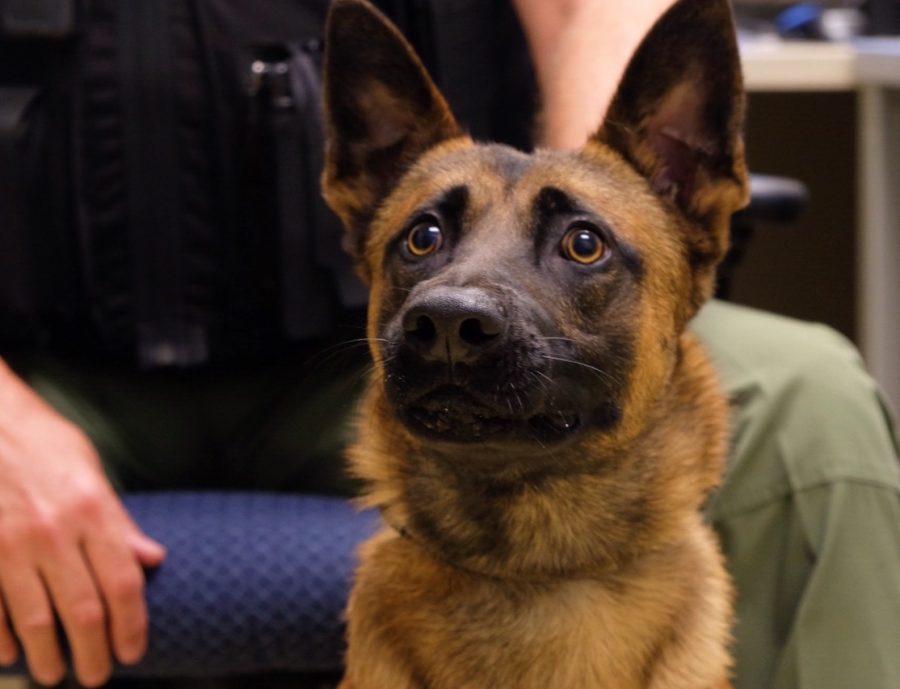Resource Officer Works With Man’s Best Friend to Keep Chamblee Safe
November 16, 2018
On October 11, Chamblee Charter High School’s level three lockdown drill may have kept students and teachers out of the hallways, but Resource Officer Joseph Bielicki and his canine partner, Dutch, were out patrolling the halls, conducting a locker investigation to ensure the safety and security of everyone within the building.
Following the days of the investigation, it became evident that Dutch was not just on campus temporarily for the lockdown drill. Students spotted Bielicki multiple times from certain classroom windows, where he was taking Dutch for a morning walk.
“Dutch, my partner, is a Belgian Malinois,” said Bielicki. “He’s trained in explosive detection, [specifically] gunpowder. […] Because gunpowder is found in ammunition, he is also able to locate guns, so we use him as a deterrent to keep them out of the schools.”
As the Canine Coordinator, Bielicki periodically goes to different schools with Dutch to conduct lockdown drills and searches, which are not unlike the October 11 lockdown. But because Bielicki has been assigned to CCHS specifically this year, Dutch does sometimes stay on campus during the school day.
“[Taking care of Dutch] is almost like having a two year old that never grows up,” said Bielicki. “I have a kennel crate here in the office, and he can stay in here and play with me. […] He marked the office the other day, and I had to clean it up. Basically, I’m following behind him, cleaning up after him, feeding him, bathing him, brushing him, playing with him. He needs a lot of exercise; he’s a very high-drive dog.”
And Dutch’s high-drive nature is what led him to becoming a detection dog in the first place. Even though he is not a German Shepherd, the traditional breed for law enforcement work, Dutch has gone through an extensive and highly selective process to get his job, despite being less than two years old.
“It’s hard to find a dog that will actually [work as a detection dog],” said Bielicki. “They have to have at least four basic drives: the hunt drive, air scent, retrieving, and prey drive. If those four drives aren’t really strong, they’re not going to make it. You see dogs fail out all the time because they can’t walk on a tile floor, or they’re scared of steps that don’t have a back.”
This wasn’t the case for Dutch, who excelled in all categories and further learned to detect gunpowder through constant training. After being first introduced to the substance’s scent, he was rewarded every time he identified it later.
“It’s repetitive, but Dutch has such a strong prey and retrieval drive that it came natural to him,” said Bielicki.
Despite being a working dog, Bielicki’s relationship with Dutch is not just professional. The two frequent many parks, where Dutch can run freely and play fetch.
“I like to take him to areas that are fenced in where I can turn him loose and play fetch with him,” said Bielicki. “He got excited because he saw some geese the other day, but as long as it’s just him and me […] there are some baseball fields and parks that I can take him to during the day.”
At the end of the school day, Dutch goes home with Bielicki.
“He’s a part of the family,” said Bielicki.
At school, the protocol for Dutch and Bielicki if a weapon were to be detected at school would start with Dutch receiving an alert from a locker.
“I would notify the administration [about the locker] first,” said Bielicki. “If there is not an immediate threat of a bomb, we will investigate it to see what’s in it. Based on the alert from the dog, the school district has the right to open the locker. If they find something, like a weapon, that’s when I take over.”
But Dutch’s role at the school is not just to sniff out weapons. According to Bielicki, he is also a mediator of sorts.
“We’ve found weapons in the school system over the years, but predominantly, [Dutch] is used as an ambassador,” said Bielicki. “A lot of the children like dogs, so because of the dog, it’s an icebreaker, and they talk to law enforcement. I’ve helped find lost or runaway children with law enforcement dogs in the past.”
Subsequently, detection dogs in schools also serve as a bridge of communication between law enforcement officers and the students themselves, which is essential in providing security.
“There’s a lot of purposes for the dog being at the school, and [Chamblee] has the notoriety of being one school out of two in the county with a dog on campus,” said Bielicki.











